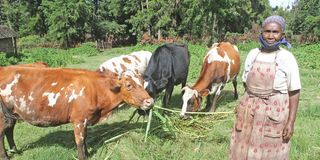Sh37.5million programme set to boost women smallholder dairy farmers

A dairy farmer feeds her cows in a farm in Elburgon, Nakuru County. Many smallholder dairy farmers in the country still remain constrained by low quantity and quality of feeds.
What you need to know:
- Kenya has the highest per capita consumption of milk in Africa
- The new collaboration is expected to have an immediate impact on the lives of Kenyan women smallholder farmers.
- At least 800,000 smallholder farmers in Kenya depend on dairy farming for their livelihoods.
At least 5,000 women smallholder dairy farmers from six counties in the country are set to benefit from a new partnership targeted at boosting their milk production, enhance income and ease the annual 2.2 billion litre shortage of dairy products in the country.
The Sh37.5 million (USD 350,000) two year programme is an initiative of Corteva Agriscience, Land O’Lakes Venture37, Bidco Land O’Lakes, Forage Genetics International (FGI) and the International Livestock Research Institute -Kenya (ILRI) and will work with small-scale women dairy farmers from Kiambu, Nakuru, Kericho, Uasin Gishu, Nyeri and Meru.
It essentially seeks to put in place measures aimed at increasing their milk production and enhancing supply of nutritional dairy products.
In the programme, Corteva will provide education and agronomic training to the women farmers, FGI will offer expert knowledge in forage management, ILRI will offer locally-based, world capabilities and livestock management practices, Land O’Lakes will offer advanced dairy technologies, while Bidco Land O’Lakes will offer expert advice on dairy animals feeding.
Targeting existing and emerging women farmers, the partnership is designed to assist them implement new methods of producing high nutrient-rich forage –including corn silage and hay– forage harvesting and conservation, and providing consistent feed for dairy cattle that will lead to improved milk production.
The farmers are also expected to be trained on mechanisation aimed at reduction of overall production costs.
Inclusive agriculture and food systems
“Kenya has the highest per capita consumption of milk in Africa at 120 liters, compared with the continent’s average of 50 liters,” said Joseph Anampiu, the Commercial Unit leader, East Africa, at Corteva Agriscience.
He noted that milk consumption is projected to nearly double to 220 liters by 2030, backed by a milk demand growth rate of seven percent per annum.
“We are committed to provide tools and training to help increase yield stability, optimise inputs, and improve climate resilience,” said Mr Anampiu.
Anne Alonzo, the Senior Vice President of external affairs at Corteva Agriscience noted that the new collaboration is expected to have an immediate impact on the lives of Kenyan women smallholder farmers, their families and their communities while Global Government and Industry Affairs lead at Corteva Agriscience, Tiffany Atwell, said the critical role women play in agriculture as well as suitable government policies can build more inclusive agriculture and food systems.
The International Fund for Agricultural Development (IFAD) notes that at least 800,000 smallholder farmers in Kenya depend on dairy farming for their livelihoods.
But despite contributing 8 percent of the country’s GDP with annual milk production of 3.43 billion litres, many farmers are yet to adopt technology to increase their milk yields.
Many smallholder dairy farmers in the country still remain constrained by low quantity and quality of feeds, lack of reliable statistical information on milk-market outlets, poor rural infrastructure, lack of collateral for loans, low technical skills on husbandry practices, and reduced access to veterinary and artificial insemination (AI) services.





